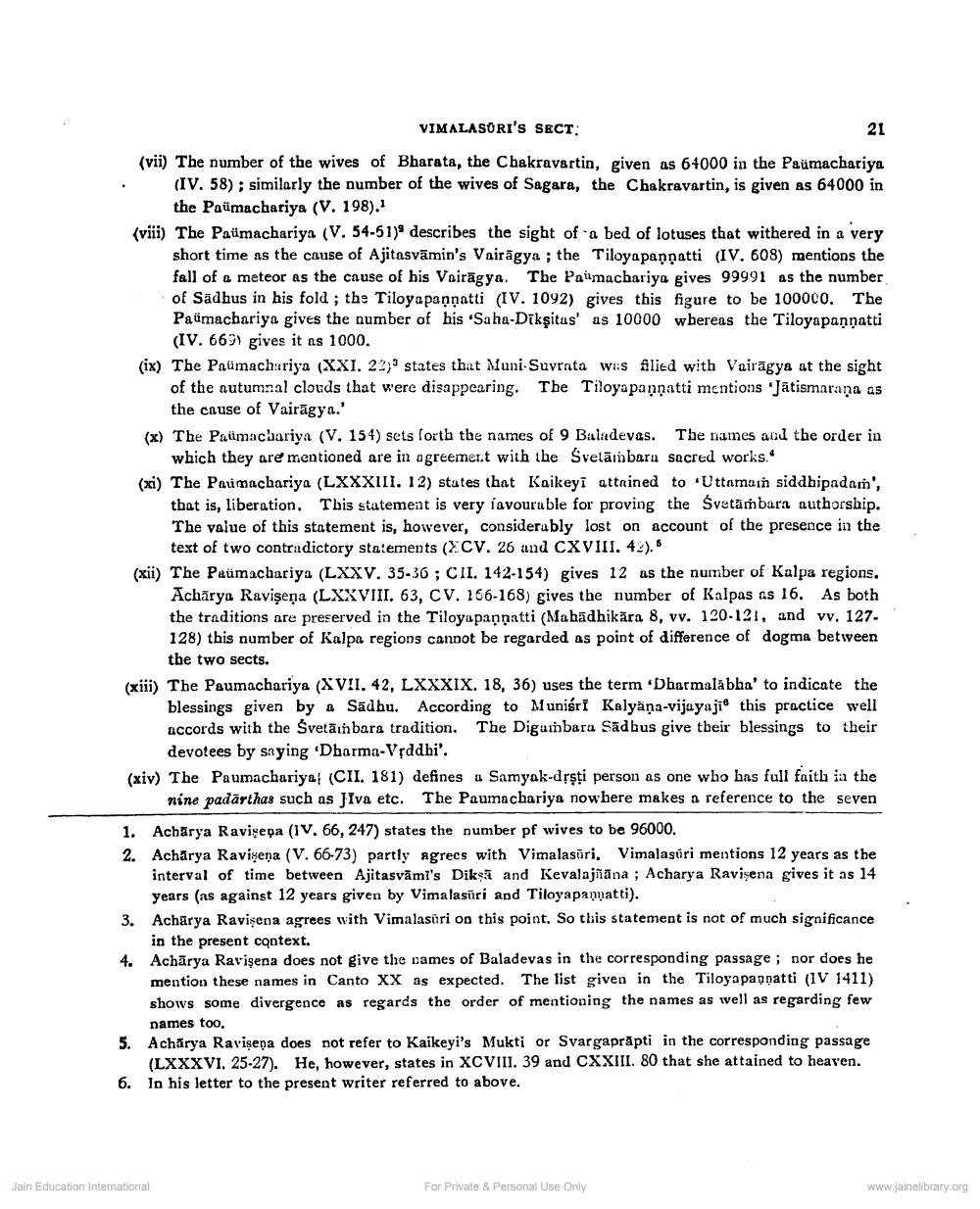________________
VIMALASURI'S SECT:
(vii) The number of the wives of Bharata, the Chakravartin, given as 64000 in the Paumachariya (IV. 58); similarly the number of the wives of Sagara, the Chakravartin, is given as 64000 in the Palmachariya (V. 198).1
(viii) The Paümachariya (V. 54-51) describes the sight of a bed of lotuses that withered in a very short time as the cause of Ajitasvamin's Vairagya ; the Tiloyapanṇatti (IV. 608) mentions the fall of a meteor as the cause of his Vairagya. The Paumachariya gives 99991 as the number of Sadhus in his fold; the Tiloyapanṇatti (IV. 1092) gives this figure to be 100000. The Paümachariya gives the number of his 'Saha-Dikşitas' as 10000 whereas the Tiloyapaṇṇatti (IV. 669) gives it as 1000.
21
(ix) The Paumachariya (XXI. 22) states that Muni Suvrata was filled with Vairagya at the sight of the autumnal clouds that were disappearing. The Tiloya pannatti mentions 'Jatismarana as the cause of Vairagya.'
(x) The Paumachariya (V. 154) sets forth the names of 9 Baladevas. The names and the order in which they are mentioned are in agreement with the Svetambara sacred works."
(xi) The Paumachariya (LXXXIII. 12) states that Kaikeyī attained to Uttamai siddhipadam', that is, liberation. This statement is very favourable for proving the Svetambara authorship. The value of this statement is, however, considerably lost on account of the presence in the text of two contradictory statements (XCV. 26 and CXVIII. 42).5
(xii) The Paumachariya (LXXV. 35-36; CII. 142-154) gives 12 as the number of Kalpa regions. Acharya Raviṣeņa (LXXVIII. 63, CV. 166-168) gives the number of Kalpas as 16. As both the traditions are preserved in the Tiloyapanpatti (Mahadhikara 8, vv. 120-121, and vv. 127. 128) this number of Kalpa regions cannot be regarded as point of difference of dogma between the two sects.
(xiii) The Paumachariya (XVII. 42, LXXXIX. 18, 36) uses the term 'Dharmalabha' to indicate the
blessings given by a Sadhu. According to Muniéri Kalyana-vijayaji this practice well accords with the Svetain bara tradition. The Digambara Sadhus give their blessings to their devotees by saying 'Dharma-Vrddhi'.
(xiv) The Paumachariya; (CII. 181) defines a Samyak-dṛṣṭi person as one who has full faith in the nine padarthas such as JIva etc. The Paumachariya nowhere makes a reference to the seven
1. Acharya Ravisepa (IV. 66, 247) states the number pf wives to be 96000.
2. Acharya Ravişena (V. 66-73) partly agrees with Vimalasūri. Vimalasuri mentions 12 years as the interval of time between Ajitasvami's Diksa and Kevalajñāna; Acharya Ravisena gives it as 14 years (as against 12 years given by Vimalasuri and Tiloyapampatti).
3. Acharya Ravişena agrees with Vimalasuri on this point. So this statement is not of much significance in the present context.
4. Acharya Ravişena does not give the names of Baladevas in the corresponding passage; nor does he mention these names in Canto XX as expected. The list given in the Tiloyapappatti (IV 1411) shows some divergence as regards the order of mentioning the names as well as regarding few names too.
5. Acharya Ravisepa does not refer to Kaikeyi's Mukti or Svargaprāpti in the corresponding passage (LXXXVI. 25-27). He, however, states in XCVIII. 39 and CXXIII. 80 that she attained to heaven. 6. In his letter to the present writer referred to above.
Jain Education International
For Private & Personal Use Only
www.jainelibrary.org




